"Somethin' Special": A Superliner History
CommentsSeptember 30, 2013
Upon assuming the operation of the nation’s intercity passenger rail system in May 1971, Amtrak faced an obvious need to upgrade its locomotive and rolling stock fleets, which had been purchased or leased from the predecessor railroads. According to early annual reports, the newest cars Amtrak initially purchased had been built for the Union Pacific Railroad in the mid-1960s, but many others had been in service for decades and required cosmetic and mechanical system overhauls.
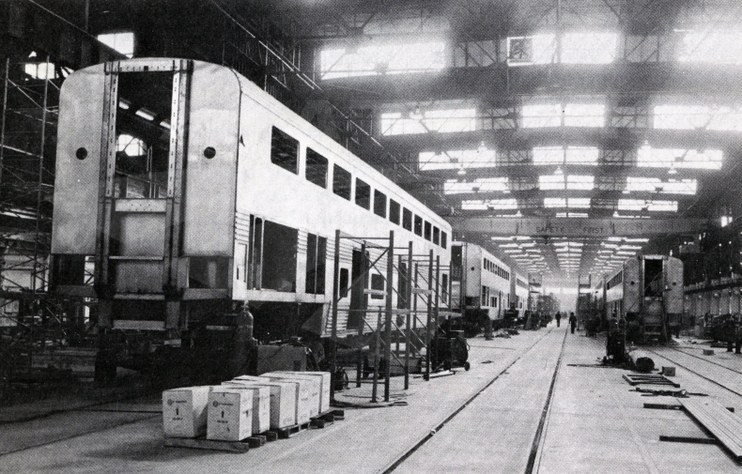
Superliner I cars were assembled by Pullman Standard at a plant
in Hammond, Ind.
Among the cars Amtrak purchased were 73 well-maintained bi-level cars from the Atchison, Topeka and Santa Fe Railway. On average 10 years old, these popular “Hi-Levels” would influence the design of new Amtrak bi-level cars that entered the development and design phase in 1973. Engineering firm Louis T. Klauder & Associates won a request for proposals to work with Amtrak on the car specifications.1
According to a 1982 article in Trains Magazine, during the specification writing, various ideas were put forth that in the end were not adopted. These included “a master tape deck for music, with individual car selection…a magazine rack by each water cooler; an illuminated message display…at each end of the car; [and] a sit-down conversation lounge on the lower level of each coach…”2 Other ideas such as lower-level passage ways and stairways at each end of the cars were dismissed early on since they took away from revenue space.
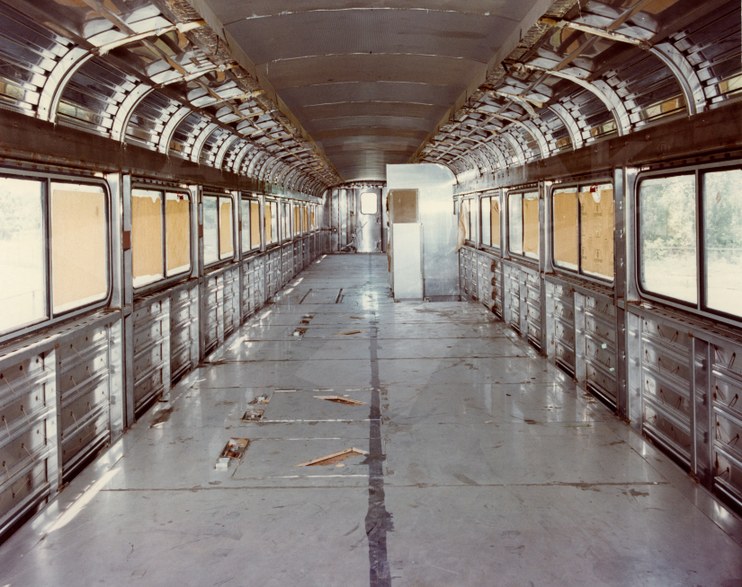
Interior shell of a Superliner I coach.
Pullman Standard won the contract that, as amended, called for production of 102 coaches, 48 coach-baggage cars, 25 café/lounge cars, 70 sleepers and 39 diners. Manufacturing took place at a plant in Hammond, Ind., with the first units expected for delivery by mid-1977. The construction process was chronicled in the pages of Amtrak NEWS, the company’s monthly employee newsletter. A February 1977 article pointed out that the “bi-level cars will be the first new equipment in Amtrak’s history that will have been designed and built to its own requirements from the rail up.” New single-level Amfleet cars manufactured by the Budd Company had gone into service starting in 1975, but their design was closely based on the earlier Metroliners produced for the Pennsylvania Railroad.
Amtrak mechanical and electrical engineers with specialties in brake systems, car body mechanics (including couplers and suspension systems) and electrical, air conditioning, temperature control and waste disposal systems advised the principal design team as specifications for the bi-levels were drawn up. This helped ensure that Amtrak mechanical personnel charged with maintaining and repairing the equipment would be comfortable with all aspects down to the smallest details. The design office under Director of Design Raul Bravo also worked on specifications for an accessible bedroom to be located on the lower level of the sleeping cars.
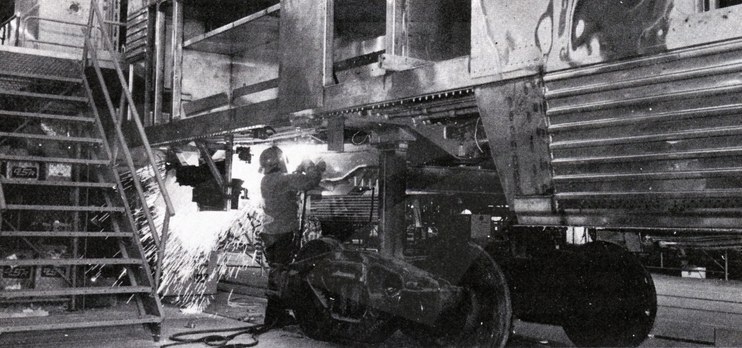
A welder works on the underside of a Superliner.
Once the first car body was completed, Pullman Standard undertook a variety of tests to confirm it was consistent with specifications. Testing focused on collision post strength to evaluate the strength of car ends; compression resistance in the event of an accident; water-tightness to guarantee no moisture entered through joints; and evaluations of trucks, brakes and car clearance. Luckily, the first car passed its tests without the need for significant design revisions.
Although intended to enter service by summer 1977, the delivery of the initial cars was delayed by more than a year due to a 27 week strike by the United Steelworkers at the Pullman Standard plant. In the meantime, Amtrak undertook other initiatives in preparation for the arrival of the bi-levels.
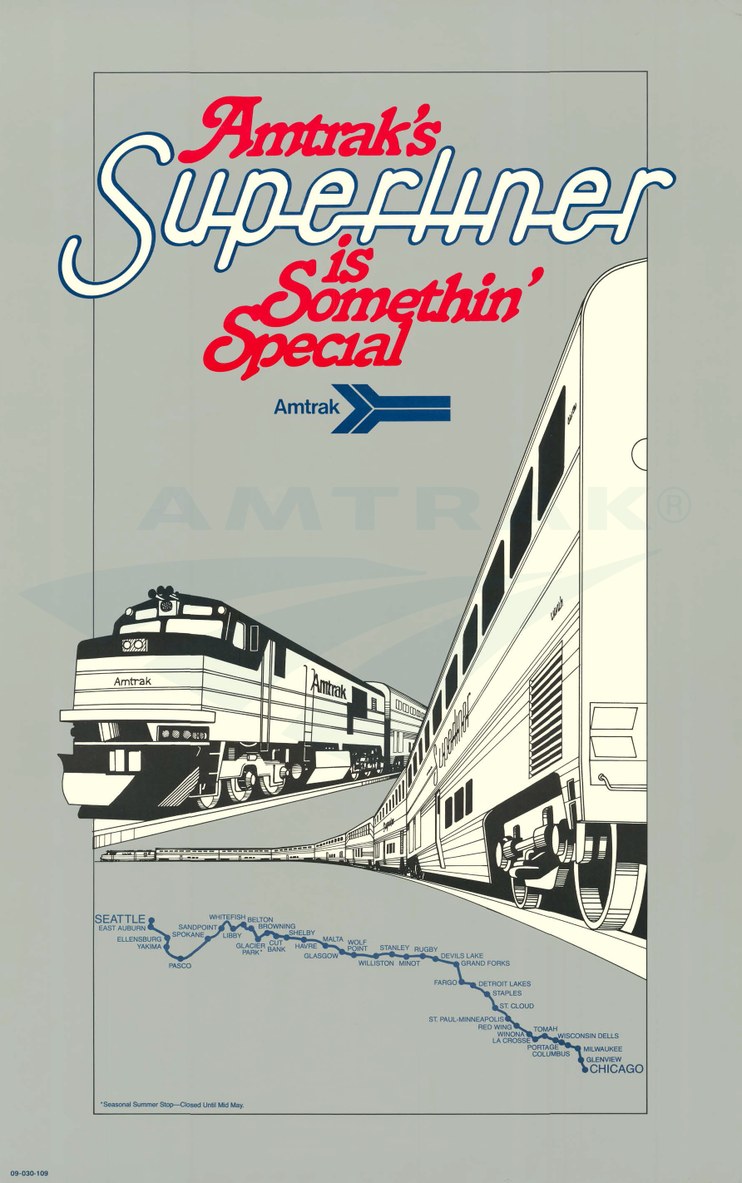
The Superliners were the first cars built
entirely to Amtrak specifications.
Employees were encouraged to enter a contest to name the new cars. The top choice, “Vistaliner,” was suggested by two people: Sales Representative Doug Deaton of Battle Creek, Mich. and Mark Walburn, a junior engineer in Washington, D.C. The name recalled earlier streamlined Vista-Dome cars whose walls of windows allowed for panoramic views of the passing scenery. As a prize, Deaton and Walburn received free train trips for their families and themselves.
Other suggestions that rated highly included “Amcruiser,” “Vistalevel,” “USA Cruiser,” “Astroliner” and “Bi-liner.” Unfortunately, after a precautionary copyright search, it was determined that none of these entries could be used because they were held by other corporations. Ultimately, Needham, Harper & Steers, the Manhattan-based advertising agency used by Amtrak, developed the name “Superliner.”
National Operations staff worked to create a training and development plan for on-board service employees, and the mechanical department assembled maintenance manuals and spare parts lists. On-board service managers visited the design department to examine interior mock-ups and try out the seating while the design team explained its choice of materials.
Amtrak also moved forward with efforts to ensure that existing maintenance facilities were capable of servicing the Superliners. Of particular importance was the Chicago 12th Street yard south of Union Station, the origination point for Superliner-equipped trains with destinations such as Seattle, Oakland and Los Angeles. Following their purchase from Conrail in 1976, the 12th and 16th Street yards underwent a five-year modernization program that included upgraded electrical systems and installation of additional servicing and storage tracks.
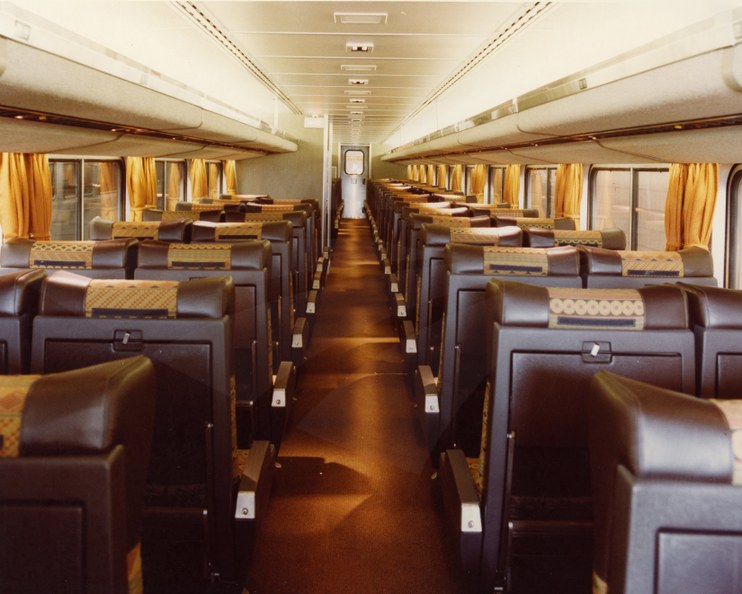
Early interiors employed a brown, beige and gold color scheme.
Amtrak finally accepted the first Superliner in October 1978, and it was used for the training of on-board service and maintenance crews. Built to be pulled at speeds up to 100 mph, the cars measure 85 feet long (to the ends of the couplers), approximately 10 feet wide and 16 feet high. Similar to the Amfleet cars, the stainless steel exteriors feature fluting that gives them a sleek, aerodynamic appearance. A reporter for Amtrak NEWS described the cars’ “subdued” color scheme of browns, beiges and greys, noting that “seat upholstery is inspired by designs of the Southwestern Indians.” Interiors were carpeted on both floors and side walls to dampen sound and provide a quiet atmosphere.
Five Superliner I configurations were produced, although they have been modified over time:
- Coach: Upper level contains 62 seats in a 2x2 configuration, while the lower level had 15 (currently 12) seats, restrooms and mechanical equipment.
- Coach-Baggage: Similar to coaches, but lower level seating area replaced by compartment for checked baggage and upper level originally configured with higher-density seating.
- Dining Car: Upper level contains 18 tables seating 72 passengers, as well as a central serving area for the service attendants. Downstairs, the fluorescent-lighted, air-conditioned, all-electric kitchen originally had convection and microwave ovens, grill, toaster, coffee maker and warming table.4
- Sleeping Cars feature various accommodations:
- Roomette (originally Economy Bedroom) with two reclining seats that convert to a comfortable bed; an upper berth folds down from above. Roomettes are located on both upper and lower levels.
- Family Bedroom: Each room has a large sofa with two individually reclining sections. At night, the sofa converts to a bed, and an upper berth folds down from above. A reclining seat and a jump seat convert to two children’s berths.
- Bedroom (originally Deluxe Bedroom): Upper and lower beds are similar to the Family Bedroom, but the Deluxe Bedroom also contains a private washroom with shower. A sliding partition allows select bedrooms to be combined into a suite.
- Accessible Bedroom: Designed for wheelchair users, each has two beds and an accessible washroom that can accommodate the turning radius of a wheelchair.
- Sightseer Lounge: On the upper level, tall wrap-around windows allow unimpeded views of the surrounding landscape, and there are informally arranged swivel chairs and love seats. Downstairs, there is a café and table seating.
Playful drawings of Superliner equipment were used on
menus in 1979.
Coaches were the first Superliners produced, followed by diners and sleeping cars. By late 1979, Amtrak had received approximately 60 of the 284 cars and expected to accept eight new cars a month. At an official Superliner unveiling ceremony held in Chicago on October 11, Amtrak President Alan Boyd enthused, “We at Amtrak think that our Superliners will mean as much to long-distance rail travel as the jumbo jets did for the airliners.” Members of the press boarded a display train with Superliner equipment; F40PHs on each end allowed for push-pull operation to create convenient photo and video opportunities.
The Empire Builder (Chicago-Seattle) was the first train to feature full Superliner service, with inaugural trains making their debut at the end of October. To mark the occasion, “Champagne was offered to adult passengers…and buttons and other souvenirs were distributed.” Earlier in the month, promotional trains with Superliner coaches, a diner and a sleeping car had covered the entire route, stopping at each Amtrak-served community to show off the new face of long-distance train travel. Visitors could tour the cars and learn about accommodations. At St. Cloud, Staples and Detroit Lakes in Minnesota, the display train welcomed approximately 5,000 enthusiastic visitors despite cool temperatures. After the Empire Builder, the first trains to receive Superliner equipment were the Desert Wind (Ogden, Utah-Los Angeles) and San Francisco Zephyr (Chicago-Oakland).
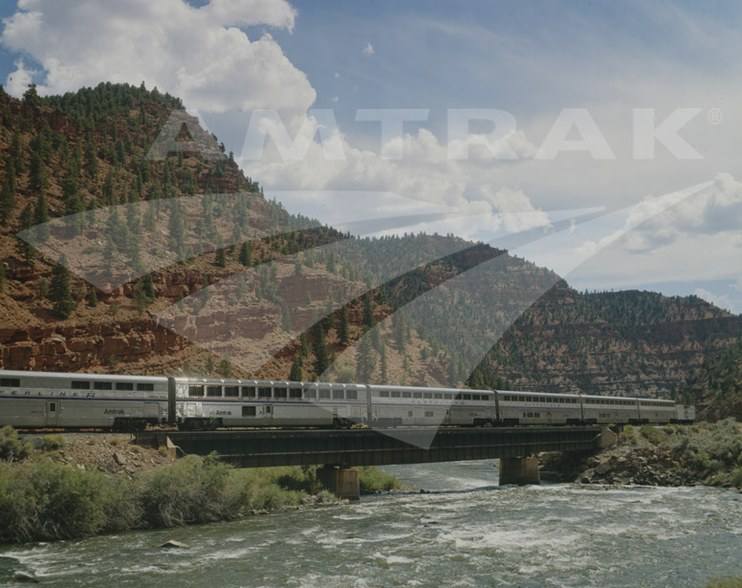
The Superliner-equipped California Zephyr glides alongside the Colorado River, c. 2000.
The final car in the 284-unit Superliner order arrived in 1981—representing a six year, $313 million capital investment on the part of the company. In that year’s Annual Report, the Superliners were touted as “the most appealing [train cars] in the world.” Increased capacity—Superliner coaches sat 77 passengers compared to 48 in older equipment, and sleepers accommodated 44 passengers versus 22 in the cars replaced—and better reliability were considered “key to the 11 percent ridership growth on long-distance trains” in fiscal year 1981.
Due to the success of the original Superliner equipment, which proved popular with customers and boosted Amtrak’s image as a modern, progressive railroad, the company placed a $340 million order for 140 additional cars in 1991. Constructed by Bombardier at plants in La Pocatiere, Quebec and Barre, Vt., the order included 38 coaches, 47 transition sleeper/dormitory cars, 25 lounge cars, 30 dining cars, 49 sleeping cars and 6 deluxe sleeping cars (the upper level contained all Bedrooms, instead of a mix of Roomettes and Bedrooms).5 The cars were intended to add capacity and replace Heritage equipment on the Capitol Limited (Washington-Chicago), Auto Train (Lorton, Va.-Sanford, Fla.) and City of New Orleans (Chicago-New Orleans).
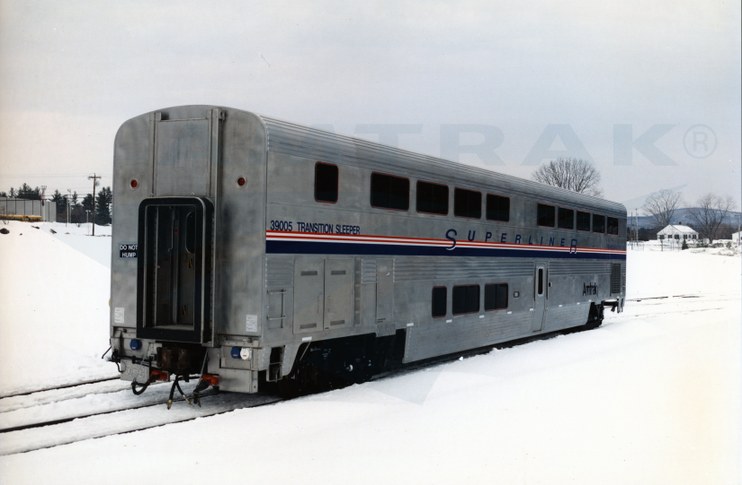
Transition Sleepers include a mix of crew dormitory rooms
and passenger Roomettes.
The Superliner II order added a sixth car type, the transition sleeper/dormitory. As its name indicates, it acts as a transition between bi-level and single-level passenger cars. Most of these cars have a mixture of crew dormitory rooms and passenger Roomettes on the upper level; crew work space on the lower level; and public restrooms and showers on both levels.
The order for the “Superliner II” cars was later increased to 195 units and all were delivered to Amtrak by 1996. As of 2012, approximately 245 Superliner I cars were still in service and about 180 Superliner II cars were in use across the national system. Five of the Santa Fe Hi-Levels, the cars that inspired the Superliners, also remain in service on the Amtrak network. These Heritage cars, now known as Pacific Parlour cars, were refurbished in the 1990s for use as lounges for sleeping car passengers on the Coast Starlight (Los Angeles-Seattle). The Superliners, in turn, served as the basis for design of the bi-level cars used in California corridor service. Although dimensions are similar to the Superliners, these new units feature additional seating and two sets of doors on the lower level for quicker boarding and detraining.
--------------------------------------------------------------------------------------------------------------------------------------
1Weinman, Michael and Raymond Cavanaugh. “How to Design a Superliner,” Trains Magazine, August 1982.
2Ibid.
3“Amtrak food is prepared the old-fashioned way,” The [Fredericksburg, Va.] Free Lance-Star, October 6, 1977.
4“Amtrak Superliners to start Chicago-Seattle run Oct. 28,” Eugene Register-Guard, October 14, 1979.
5“Amtrak buying new long-distance cars,” Gainesville [Florida] Sun, April 23, 1991.
Additional Works Consulted
National Railroad Passenger Corporation, Annual Reports for fiscal years 1973-1981 and 1991-1996.
Articles from Amtrak NEWS:
“Corridor Takeover, New Equipment Highlight Amtrak’s 1976,” January 15, 1977, 1-3.
“Cooperative Engineering Efforts Result In Superior Bi-level Cars,” February 15, 1977, 4-5.
“Name The Bi-level Contest Winners Picked,” June 1, 1977, 2.
“On-board Managers Named,” June 15, 1977, 7.
“Pullman Strike Settled,” May 1978, 10.
“First Superliner Car Accepted,” November 1978, 1 and 11.
“Superliner Diner,” August 1979, 3.
“Superliners Go Into Service On Empire Builder Route,” November 1979, 1.
“Superliner Press Preview,” November 1979, 6.
“Superliner on Desert Wind, Zephyr; 403(B) Activity In Several States,” July 1980, 1-2.
“Superliner Update,” July 1980, 10.




